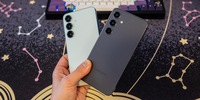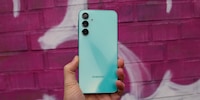
Galaxy S24 Ultra review – Samsung’s top phone is even better
Improvements to the Galaxy S24 Ultra are mostly minor, but it all adds up to make a big difference compared to the predecessor.
After almost six weeks of testing, it’s time to draw a conclusion about the Galaxy S24 Ultra. The flat display, Galaxy AI and the reduced focal length of the telephoto camera receive the most attention.
Flat, robust display with fewer reflections
After many years of displays with rounded sides, Samsung has returned to a flat display with the Galaxy S24 Ultra. I don’t like the reflections on round edges, so I welcome the change. In return, I can accept a small reduction in the screen-to-body ratio. It’s fallen from 89.9% to 88.9% compared to the S23 Ultra.
In contrast, the brightness of the 6.8-inch S24 Ultra AMOLED display has increased significantly. However, there are only figures on peak brightness. Samsung specifies 2,600 nits, which it almost reaches in independent measurements. For everyday use, however, a typical and not peak brightness value would be of interest. Samsung doesn’t specify this, and I haven’t yet found any measurements. To my eyes, the display of the S24 Ultra is very easy to read, even in direct sunlight. However, this is now standard among top smartphones.
Source: Jan Johannsen
Gorilla Glass Armor isn’t yet a standard. Samsung’s the first smartphone manufacturer to use the latest generation of shatterproof and scratch-resistant Corning glass. I haven’t thrown my test device around yet, but I’m still impressed by Gorilla Glass Armor. It significantly reduces reflections when looking at the display. JerryRigEverything demonstrates how stable the glass and new titanium frame are.
Galaxy AI: artificial intelligence isn’t yet fully developed
The AI boom doesn’t stop at Samsung. With the S24 series, the company bundled various functions under the Galaxy AI label. These include an interpreter app, live phone call translations, text summaries, transcriptions of audio recordings and image editing assistants. This ranges from removing shadows and reflections to generative image extensions.
While live translating phone calls is something new, the interpreter app is just Samsung’s version of the Translate app Google’s been offering for years. And the Samsung clone isn’t linguistically perfect. However, the company intends to continuously improve its software.
I’d mainly use the translation tools when I’m on vacation. The camera features, on the other hand, are an everyday companion. Recognising and removing shadows is hardly necessary thanks to good HDR modes. However, I like that AI removes reflections that occur when photographing through glass.
Samsung has since announced that Galaxy AI will also be coming to the S23 series and other top devices from 2023. This won’t make the S24 series any worse, it just negates one of its unique selling points.
A new camera and little change
With one exception, Samsung uses the same camera system in the Galaxy S24 Ultra as in the predecessor model. Only the second telephoto camera for long focal lengths is different. However, the manufacturer has reduced its optical zoom from ten times to five times magnification. The resolution of the image sensor is now 50 megapixels instead of 10. One of Samsung’s reasons for this? Apparently, users greatly prefer fivefold magnification over 10x. In addition, the larger image sensor ensures that tenfold digital zoom is no worse than the optical zoom of its predecessor. Fellow editor Lorenz Keller double-checked this.
His conclusion: «Despite its seemingly «worse» optical zoom, the S24 Ultra can pretty much go toe-to-toe with its predecessor. Even so, the new zoom system isn’t visibly better than the S23 Ultra’s. It really depends on what you use on a day-to-day basis. If you generally go for a zoom range of 3x to 5x, there’s not much between the two phones. At 5x to 10x, the S24 Ultra is more impressive. At 10x or just above, the S23 Ultra is better.»
Source: Jan Johannsen
With the cameras unchanged – apart from the telephoto – the Galaxy S24 Ultra continues to deliver very good image quality. The «old» hardware isn’t a drawback, as most improvements in the camera sector these days are made at the software level during post-processing. This can be seen, for example, in a comparison with the Pixel 8 Pro, which I highly praised in autumn.
Daylight results
Both deliver high-quality images in daylight, but one could argue about which colours are more natural. Samsung focuses on warmth by adding a little more yellow to the picture.
Zoom in action
When it comes to zoom, I test the fivefold magnification that both smartphones can achieve optically. From St Peter-Ording, the Westerhever lighthouse is still a long way away, but using zoom it’s easier to see than with the naked eye. Differences in colour reproduction are more obvious than those in the level of detail. However, I can’t decide which snapshot I prefer. The Galaxy S24 Ultra is somewhat clearer, but also harder.
Digitally, I can get closer to the lighthouse with both smartphones using 30x zoom.
The different image sections support Samsung’s claim that people don’t want a huge focal length quite clearly. Even small movements cause large changes in different image sections. This doesn’t prevent Samsung from continuing to offer its 100x digital zoom.
Night mode
Both smartphones use a longer exposure time in night mode. The Galaxy S24 Ultra takes around two seconds to take a picture, while the Pixel 8 Pro takes five to six seconds. That seems a little long to me, especially as the street lamps are unsharp and the picture is too bright for a night shot, in my opinion. The S24 Ultra looks sharper, not overexposed, and has a more pleasant colour with a little more yellow instead of white.
Selfies
The level of detail is identical for selfies. However, the Galaxy S24 Ultra provides a little more yellow for more warmth in its shot. My skin looks less pale in the midday sun hitting me from the side, and I look better.
Plenty of power
With its Snapdragon 8 Gen 3, the Samsung Galaxy S24 Ultra currently sports the most powerful chipset for Android devices. This means it performs better while drawing less power than its predecessor. The chipset is also further optimised for AI applications. In everyday use, you won’t push the S24 Ultra to its performance limits, even with games.
If you want to back up these claims with figures, I refer you to the article by my colleague Lorenz Keller. He explicitly investigated why Samsung returned to its own processors for the S24 and S24 Plus. The Exynos 2400 performs slightly worse than the Snapdragon 8 Gen 3 in the S24 Ultra. But the difference isn’t as significant as in the past, and the Exynos isn’t an automatic loser this year.
A battery that lasts ages
Looking at the S24 Ultra’s data sheet, nothing has changed in terms of the battery. It has a capacity of 5,000 mAh and draws up to 45 watts via USB-C, enough to fully charge it in about an hour. It can be charged wirelessly with up to 15 watts and can charge other devices wirelessly with up to 4.5 watts.
I was particularly impressed by its runtime – 10:58 hours in the PCMark battery test at maximum display brightness. This means that the S24 Ultra even outperforms the less bright Nothing Phone (2) – 10:56 hours – by a narrow margin and the similarly bright Pixel 8 Pro – 6:21 hours – by a landslide. Only the S24 Plus with the previously unpopular Exynos 2400 lasts longer than the S24 Ultra at 11:22 hours.
S Pen and DeX: unchanged this year
The Galaxy Ultra succeeded the Note series at Samsung four years ago, adopting the S Pen. This makes it the only relevant smartphone with an integrated stylus. Although it offers practical functions, nothing new has been added this year. Writing, drawing and the pen as a remote control are also not my thing. In everyday life, the stylus withers away in my smartphone.
Source: Jan Johannsen
Samsung DeX isn’t exclusive to the S24 Ultra. The desktop interface for Android is available down to mid-range devices. It doesn’t offer anything new this year. As a result, my verdict remains the same – can be useful, but not a permanent alternative to a real computer.
In a nutshell
Small improvements provide a better overall picture
The Samsung Galaxy S24 Ultra impresses with a flat and very bright display that’s durable and less reflective. In addition, the battery lasts ages, and Samsung promises to provide software updates for seven years for the very first time.
Performance has increased again compared to the predecessor – which already offered plenty for most use cases. There’s only one change to the camera, which isn’t a step backwards despite less optical zoom. Overall, the S24 Ultra continues to be one of the best phones for photography.
Galaxy AI has potential, but is still a long way from being fully developed, especially in the voice sector. Thankfully, Samsung is also bringing its artificial intelligence to older models – which does take away some of the S24 Ultra’s exclusivity.
Overall, the display, battery and software update pledge are the main reasons why the S24 Ultra is better than the S23 Ultra.
Pro
- flat display with Gorilla Glass Armor
- very long battery life
- 7 years of software updates
Contra
- Galaxy AI still has to improve
- S Pen and DeX without major innovations
25 people like this article
As a primary school pupil, I used to sit in a friend's living room with many of my classmates to play the Super NES. Now I get my hands on the latest technology and test it for you. In recent years at Curved, Computer Bild and Netzwelt, now at Digitec and Galaxus.













